-
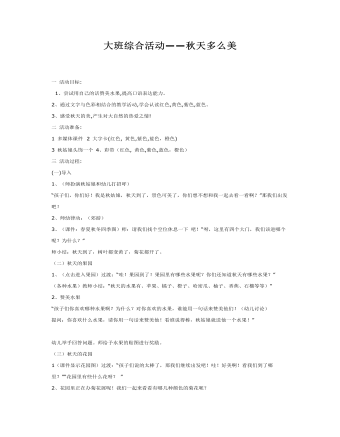
大班综合教案:秋天多么美
二活动准备:1 多媒体课件 2 大字卡(红色, 黄色,紫色,蓝色,橙色)3 秋姑娘头饰一个 4、彩带(红色, 黄色,紫色,蓝色,橙色) 三活动过程:(一)导入1、(师扮演秋姑娘和幼儿打招呼)“孩子们,你们好!我是秋姑娘,秋天到了,景色可美了,你们想不想和我一起去看一看啊?”那我们出发吧!2、师幼律动:(郊游) 3、(课件:春夏秋冬四季图)师:请我们找个空位休息一下吧!“呀,这里有四个大门,我们该进哪个呢?为什么?”师小结:秋天到了,树叶都变黄了,菊花都开了。 (二)秋天的果园1、(点击进入果园)过渡:“哇!果园到了!果园里有哪些水果呢?你们还知道秋天有哪些水果?” (各种水果)教师小结:“秋天的水果有、苹果、橘子、橙子、哈密瓜、柚子、香蕉、石榴等等)”
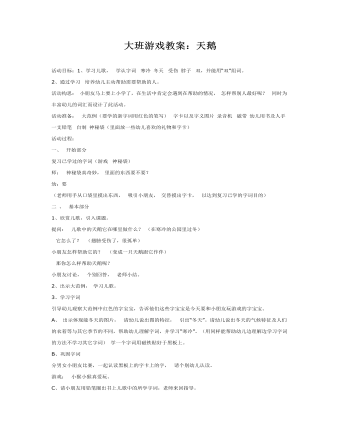
大班游戏教案:天鹅
一、 开始部分复习已学过的字词(游戏 神秘袋)师: 神秘袋真奇妙,里面的东西要不要?幼:要(老师用手从口袋里摸出东西, 吸引小朋友,交替摸出字卡, 以达到复习已学的字词目的)二、 基本部分1、欣赏儿歌,引入课题。提问: 儿歌中的天鹅它在哪里做什么?(在寒冷的公园里过冬) 它怎么了? (翅膀受伤了,很孤单)小朋友怎样帮助它的? (变成一只天鹅跟它作伴) 那你怎么样帮助天鹅呢?小朋友讨论, 个别回答, 老师小结。2、出示大范例,学习儿歌。
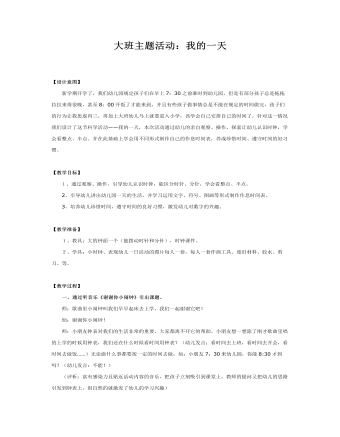
大班主题教案:我的一天
【教学目标】 1、通过观察、操作,引导幼儿认识时钟,能区分时针、分针,学会看整点、半点。2、引导幼儿讲出幼儿园一天的生活,并学习运用文字、符号、图画等形式制作作息时间表。3、培养幼儿珍惜时间,遵守时间的良好习惯,激发幼儿对数字的兴趣。 【教学准备】 1、教具:大的钟面一个(能拨动时针和分针),时钟课件。 2、学具:小时钟、表现幼儿一日活动的图片每人一套,每人一套作画工具、废旧材料、胶水、剪刀、等。
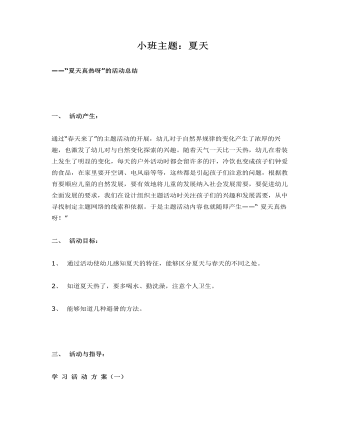
小班主题:夏天课件教案
二、 活动目标:1、 通过活动使幼儿感知夏天的特征,能够区分夏天与春天的不同之处。2、 知道夏天热了,要多喝水、勤洗澡,注意个人卫生。3、 能够知道几种避暑的方法。三、 活动与指导:学习活动方案(一)内 容认识夏天活动目标1、通过观察夏天的景色和各种树叶、小草的变化,初步知道夏天到了。2了解夏天的特征,萌发幼儿对大自然的热爱之情。活动准备活动前让父母带幼儿去公园帮助观察夏天的景色和各种树叶、小草的变化,散步活动时引导幼儿观赏幼儿园的风景。流 程谈话活动----欣赏图片----布置墙面
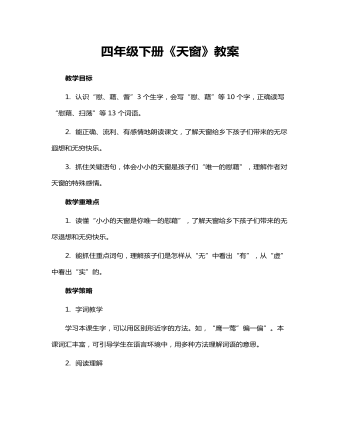
四年级下册《天窗》教案
教学目标1. 认识“慰、藉、瞥”3个生字,会写“慰、藉”等10个字,正确读写“慰藉、扫荡”等13个词语。2. 能正确、流利、有感情地朗读课文,了解天窗给乡下孩子们带来的无尽遐想和无穷快乐。3. 抓住关键语句,体会小小的天窗是孩子们“唯一的慰藉”,理解作者对天窗的特殊感情。教学重难点1. 读懂“小小的天窗是你唯一的慰藉”,了解天窗给乡下孩子们带来的无尽退想和无穷快乐。2. 能抓住重点词句,理解孩子们是怎样从“无”中看出“有”,从“虚”中看出“实”的。教学策略1. 字词教学学习本课生字,可以用区别形近字的方法。如,“鹰一莺”编一偏”。本课词汇丰富,可引导学生在语言环境中,用多种方法理解词语的意思。2. 阅读理解主要采用提出问题引导阅读的方式教学:先让学生带着疑问读课文,接着细读课文并思考天窗给乡下的孩子带来了什么,然后抓住文章的中心句“小小的天窗是你唯一的慰藉”一句理解课文,最后结合全文内容体会孩子被唤回家时的失落,又从天窗中想象出无穷的情形、故事,找回了失去的快乐。3. 表达运用运用读写结合的策略,学习课文后,启发学生结合自己的生活实际谈感受,写感受。教学准备1. 预习提纲:完成《状元大课堂·好学案》对应课文预习作业。2. 准备资料:多媒体课件。教学课时:2课时第1课时,课时目标:1. 认识“慰、藉、瞥”3个生字,会写“慰、藉”等10个字,正确读写“慰藉、扫荡”等13个词语。2. 能正确、流利地朗读课文,整体感知课文主要内容,理清课文脉络。教学过程板块一,设疑激趣,导入新课。1. 导入新课。(1) 课件出示天窗图片。(2) 师引导:同学们,你们知道这是什么吗?(3) 了解课文题目。师板书课题:天窗;指名读课题。(4) 设置疑问。师引导:看到课题,同学们有什么想问的吗?(示例:什么是天窗?)
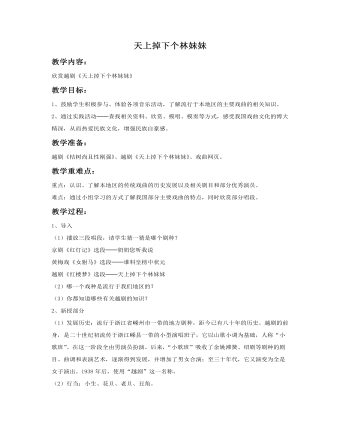
《天上掉下个林妹妹》教案
教学过程:1、导入(1)播放三段唱段,请学生猜一猜是哪个剧种?京剧《红灯记》选段──奶奶您听我说黄梅戏《女驸马》选段──谁料皇榜中状元越剧《红楼梦》选段──天上掉下个林妹妹(2)哪一个戏种是流行于我们地区的?(3)你都知道哪些有关越剧的知识?2、新授部分(1)发展历史:流行于浙江省嵊州市一带的地方剧种,距今已有八十年的历史。越剧的前身,是二十世纪初流传于浙江嵊县一带的小型演唱班子,它以山歌小调为基础,人称“小歌班”。在这一阶段全由男演员扮演。后来,“小歌班”吸收了余姚滩簧、绍剧等剧种的剧目、曲调和表演艺术,逐渐得到发展,并增加了男女合演;至三十年代,它又演变为全是女子演出。1938年后,使用“越剧”这一名称。(2)行当:小生、花旦、老旦、丑角。 (3)欣赏《天上掉下个林妹妹》设问的问题:这是哪出戏中的唱段?演员扮演的是哪个行当?简单了解《红楼梦》的剧情。模唱:感受音乐风格。(4)分析:两个角色分别是谁?属于哪个行当?(5)总结越剧的音乐风格特点:清悠婉丽。
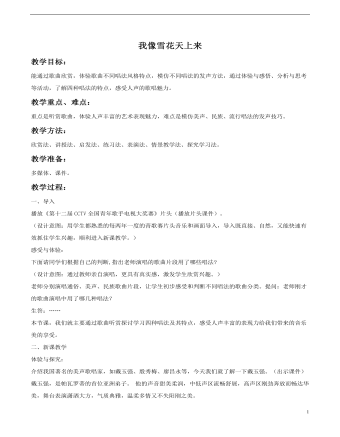
《我像雪花天上来》教案
教学过程:一、导入播放《第十二届CCTV全国青年歌手电视大奖赛》片头(播放片头课件)。(设计意图:用学生都熟悉的每两年一度的青歌赛片头音乐和画面导入,导入既直接、自然,又能快速有效抓住学生兴趣,顺利进入新课教学。)感受与体验:下面请同学们根据自己的判断,指出老师演唱的歌曲片段用了哪些唱法?(设计意图:通过教师亲自演唱,更具有真实感,激发学生欣赏兴趣。)老师分别演唱通俗、美声、民族歌曲片段,让学生初步感受和判断不同唱法的歌曲分类。提问:老师刚才的歌曲演唱中用了哪几种唱法?生答:……本节课,我们就主要通过歌曲听赏探讨学习四种唱法及其特点,感受人声丰富的表现力给我们带来的音乐美的享受。二、新课教学体验与探究:介绍我国著名的美声歌唱家,如戴玉强、殷秀梅、廖昌永等,今天我们就了解一下戴玉强。(出示课件)戴玉强,是帕瓦罗蒂的首位亚洲弟子。他的声音甜美柔润,中低声区流畅舒展,高声区刚劲奔放而畅达华美,舞台表演潇洒大方,气质典雅,温柔多情又不失阳刚之美。
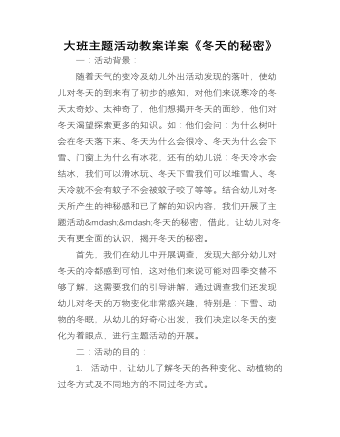
《冬天的秘密》主题活动教案
一:活动背景: 随着天气的变冷及幼儿外出活动发现的落叶,使幼儿对冬天的到来有了初步的感知,对他们来说寒冷的冬天太奇妙、太神奇了,他们想揭开冬天的面纱,他们对冬天渴望探索更多的知识。如:他们会问:为什么树叶会在冬天落下来、冬天为什么会很冷、冬天为什么会下雪、门窗上为什么有冰花,还有的幼儿说:冬天冷水会结冰,我们可以滑冰玩、冬天下雪我们可以堆雪人、冬天冷就不会有蚊子不会被蚊子咬了等等。结合幼儿对冬天所产生的神秘感和已了解的知识内容,我们开展了主题活动——冬天的秘密,借此,让幼儿对冬天有更全面的认识,揭开冬天的秘密。 首先,我们在幼儿中开展调查,发现大部分幼儿对冬天的冷都感到可怕,这对他们来说可能对四季交替不够了解,这需要我们的引导讲解,通过调查我们还发现幼儿对冬天的万物变化非常感兴趣,特别是:下雪、动物的冬眠,从幼儿的好奇心出发,我们决定以冬天的变化为着眼点,进行主题活动的开展。 二:活动的目的: 1. 活动中,让幼儿了解冬天的各种变化、动植物的过冬方式及不同地方的不同过冬方式。 2. 冬天的活动及冬天的节日,使幼儿对冬天由更进一步的了解,从而对冬天有更深的认识。 三;主题活动网络图: 昼长夜短 寒冷 雪花、冰雹 变化 的冬季 冬眠、南迁、躲 天气 现象 不同地方 储备食物、冬眠、 圣诞节、元旦、春节 冬天的景色 过冬方式 冬天的节日 冬天的秘密 动物 动物趣闻 冬天的活动 植物人类的变化 衣服的变化 蔬菜、庄稼 跳绳、堆雪人 制作漂亮 树、花 食物 疾病 取暖 天冷我不怕 踢毽子 的冬装 常绿树、落叶树 预防感冒 树叶找家 注: 为教师预设内容、 师生共同生成、 为幼儿生成
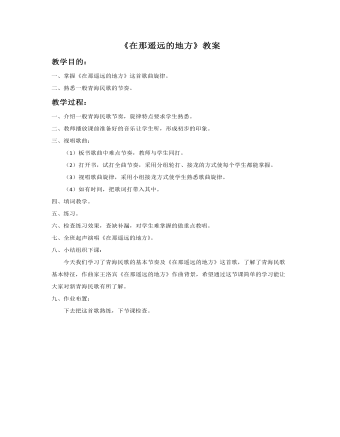
《在那遥远的地方》教案
教学过程:一、介绍一般青海民歌节奏,旋律特点要求学生熟悉。二、教师播放课前准备好的音乐让学生听,形成初步的印象。三、视唱歌曲: (1)板书歌曲中难点节奏,教师与学生同打。 (2)打开书,试打全曲节奏,采用分组轮打、接龙的方式使每个学生都能掌握。 (3)视唱歌曲旋律,采用小组接龙方式使学生熟悉歌曲旋律。 (4)如有时间,把歌词打带入其中。四、填词教学。五、练习。六、检查练习效果,查缺补漏,对学生难掌握的做重点教唱。七、全班起声演唱《在那遥远的地方》。八、小结组织下课: 今天我们学习了青海民歌的基本节奏及《在那遥远的地方》这首歌,了解了青海民歌基本特征,作曲家王洛宾《在那遥远的地方》作曲背景,希望通过这节课简单的学习能让大家对新青海民歌有所了解。九、作业布置: 下去把这首歌熟练,下节课检查。
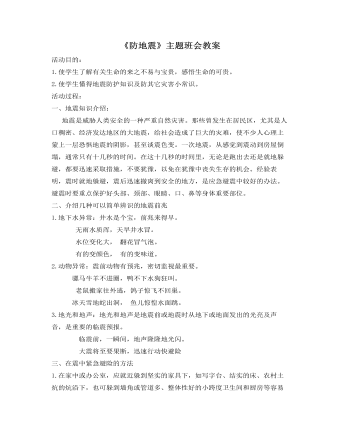
《防地震》主题班会教案
活动目的:1.使学生了解有关生命的来之不易与宝贵,感悟生命的可贵。2.使学生懂得地震防护知识及防其它灾害小常识。活动过程:一、地震知识介绍:地震是威胁人类安全的一种严重自然灾害。那些曾发生在居民区,尤其是人口稠密、经济发达地区的大地震,给社会造成了巨大的灾难,使不少人心理上蒙上一层恐惧地震的阴影,甚至谈震色变。一次地震,从感觉到震动到房屋倒塌,通常只有十几秒的时间。在这十几秒的时间里,无论是跑出去还是就地躲避,都要迅速采取措施,不要犹豫,以免在犹豫中丧失生存的机会。经验表明,震时就地躲避,震后迅速撤离到安全的地方,是应急避震中较好的办法。避震时要重点保护好头部、颈部、眼睛、口、鼻等身体重要部位。
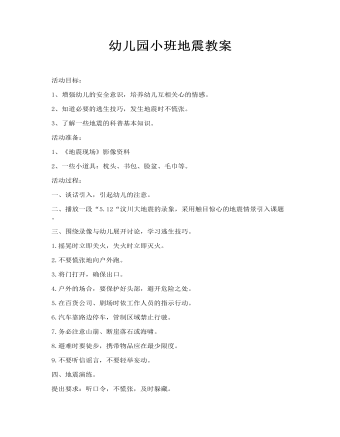
幼儿园小班地震教案
二、播放一段“5.12“汶川大地震的录象,采用触目惊心的地震情景引入课题。三、围绕录像与幼儿展开讨论,学习逃生技巧。1.摇晃时立即关火,失火时立即灭火。2.不要慌张地向户外跑。3.将门打开,确保出口。4.户外的场合,要保护好头部,避开危险之处。5.在百货公司、剧场时依工作人员的指示行动。6.汽车靠路边停车,管制区域禁止行驶。
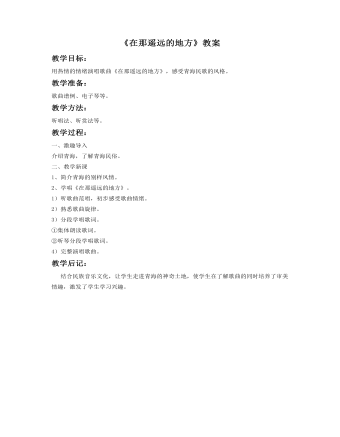
《在那遥远的地方》教案
教学目标:用热情的情绪演唱歌曲《在那遥远的地方》,感受青海民歌的风格。教学准备:歌曲谱例、电子琴等。教学方法:听唱法、听赏法等。教学过程:一、激趣导入介绍青海,了解青海民俗。二、教学新课1、简介青海的别样风情。2、学唱《在那遥远的地方》。 1)听歌曲范唱,初步感受歌曲情绪。2)熟悉歌曲旋律。3)分段学唱歌词。①集体朗读歌词。②听琴分段学唱歌词。4)完整演唱歌曲。教学后记:结合民族音乐文化,让学生走进青海的神奇土地,使学生在了解歌曲的同时培养了审美情趣,激发了学生学习兴趣。
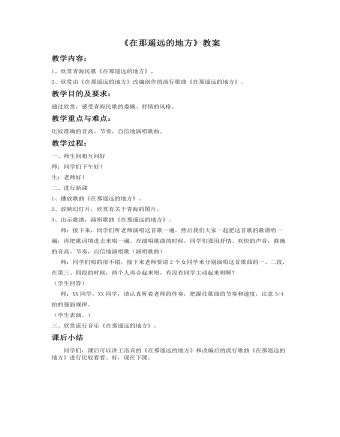
《在那遥远的地方》教案
教学过程:一、师生间相互问好师:同学们下午好!生:老师好!二、进行新课 1、播放歌曲《在那遥远的地方》。2、放映幻灯片,欣赏有关于青海的图片。3、出示歌谱,演唱歌曲《在那遥远的地方》。 师:接下来,同学们听老师演唱这首歌一遍,然后我们大家一起把这首歌的歌谱唱一遍,再把歌词填进去来唱一遍。在演唱歌曲的时候,同学们要用抒情、欢快的声音,准确的音高、节奏,自信地演唱歌(演唱歌曲) 师:同学们唱的很不错,接下来老师要请2个女同学来分别演唱这首歌曲的一、二段,在第三、四段的时候,两个人再合起来唱,有没有同学主动起来唱啊?(学生回答) 师:XX同学,XX同学,请认真听着老师的伴奏,把握住歌曲的节奏和速度,注意3/4拍的强弱规律。(学生表演。)三、欣赏流行音乐《在那遥远的地方》。

歌剧《白毛女》选段教案
教学过程:一、鉴赏对比《北风吹》《扎红头绳》{过渡语}师:刚才我们欣赏了歌剧《白毛女》的几个著名片段,你能在刚才的歌曲中找一找歌剧需要具备的要素吗?同学们来比较一下:北风吹和扎红头绳表现出的不同的音乐要素?下面由同学们来一起分组讨论: 曲 目 速度 力度 音色 演唱形式 表达情绪 音乐特点《北风吹》 中 中弱 女高音 女声独唱 天真、期盼 下行休止符运用《扎红头绳》 快 中 女高音 对 唱 欢快、活泼 旋律跳进,节奏密集设计意图:学生通过选用合适的音乐为故事配音的活动,更深刻地认识音乐在其中的作用。师:刚从我们的小演员的表现中我们所感受到不同的音乐情绪:天真期盼、欢快、悲恸。音乐根据不同需要可以刻画出不同的艺术形象表达不同的情感。我们还知道了对塑造刻画音乐形象起重要作用的是音乐作品中的音乐要素。二、情景剧编创老师简析:(导出情景剧表演) 1,师:你能说一说他们的声音有什么特点吗?(喜儿:声音清脆、甜美 杨:浑厚、低沉)2. 出示歌谱,学生模仿二人的声音朗读歌词。 再次听赏歌曲,体会两首歌曲的旋律特点。(《北风吹》:舒缓 《扎红头绳》:欢快)3. 模仿二人的声音演唱歌曲《扎红头绳》。4. 师:听了他们的声音,你能描绘出他们的形象吗?设计意图:学生通过听、看,感受不同人物的音色特点,并能听辨不同情绪的音乐,能用语言作简单描述,并通过歌曲了解故事发展情节。

歌剧《白毛女》选段教案
教学过程:一、创设情景、激趣引入欢迎大家来到今天的音乐课堂。老师为你们准备了一段舞蹈,大家想看吗?教师表演《白毛女》)刚刚老师跳舞时的音乐大家有没有听过?他叫什么名字?你知不知道他是选自哪部电影里的音乐。(《白毛女》)在课前,老师让大家收集了有关电影《白毛女》的资料,哪位同学愿意跟大伙说说你收集的情况。(学生展示收集情况,教师进行点评。)老师也在网上、新华书店收集到了《白毛女》中的一些音乐资料,现在请大家来欣赏一下,同时帮教师辨别一下,它们都采用了哪些形式来表现歌曲。二、模仿外形、感受形象师:通过这些视频资料,大家可能对《白毛女》中的两位主角从形象上有了更进一步的了解,下面让我们来玩个游戏,大家看过“模仿秀”节目没有?想不想今天也来亲身参与、秀上一把。首先进入第一关:形象模仿。请各组选出两位模特,利用老师提供的材料,从外形上模仿一下喜儿、杨白劳。限时3分钟看哪一组模仿得又快又像。师:时间到,让我们来看看各组的完成情况。掌声有请我们的模特上场。从他们的这身打扮上你们觉得人物会具有怎样的性格。(学生回答)教师补充:喜儿是一个天真可爱的小姑娘,而杨白劳则是一个受尽了剥削、很老实的一个农民。请我们的模特们做出几个符合人物性格特点的动作!
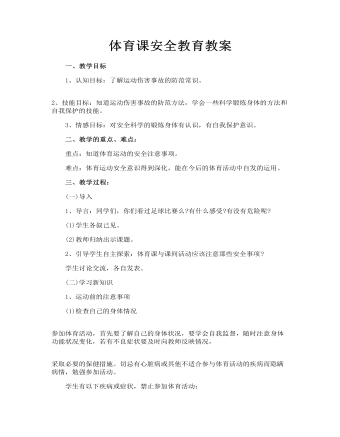
体育课安全教育教案
(一)导入 1、导言:同学们,你们看过足球比赛么?有什么感受?有没有危险呢? (1)学生各叙己见。 (2)教师归纳出示课题。 2、引导学生自主探索:体育课与课间活动应该注意那些安全事项? 学生讨论交流,各自发表。 (二)学习新知识 1、运动前的注意事项 (1)检查自己的身体情况 参加体育活动,首先要了解自己的身体状况,要学会自我监督,随时注意身体功能状况变化,若有不良症状要及时向教师反映情况, 采取必要的保健措施。切忌有心脏病或其他不适合参与体育活动的疾病而隐瞒病情,勉强参加活动。
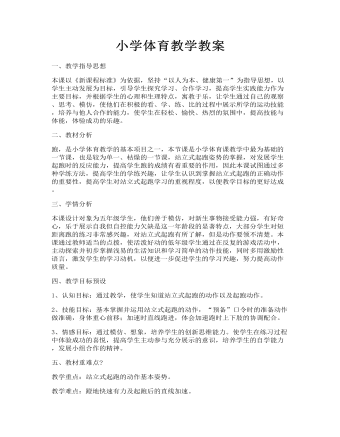
小学体育教学教案
二、教材分析跑,是小学体育教学的基本项目之一,本节课是小学体育课教学中最为基础的一节课,也是较为单一、枯燥的一节课,站立式起跑姿势的掌握,对发展学生起跑时的反应能力,提高学生跑的成绩有着重要的作用,因此本课试图通过多种学练方法,提高学生的学练兴趣,让学生认识到掌握站立式起跑的正确动作的重要性,提高学生对站立式起跑学习的重视程度,以便教学目标的更好达成。三、学情分析本课设计对象为五年级学生,他们善于模仿,对新生事物接受能力强,有好奇心,乐于展示自我但自控能力欠缺是这一年龄段的显著特点,大部分学生对短距离跑的练习非常感兴趣,对站立式起跑有所了解,但是动作要领不清楚。本课通过教师适当的点拨,使活泼好动的低年级学生通过在反复的游戏活动中,主动探索并初步掌握浅易的生活知识和学习简单的动作技能,同时多用激励性语言,激发学生的学习动机,以便进一步促进学生的学习兴趣,努力提高动作质量。
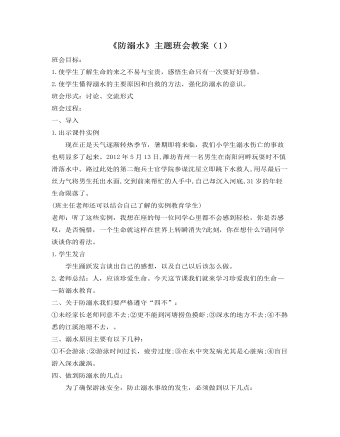
《防溺水》主题班会教案(1)
班会目标: 1.使学生了解生命的来之不易与宝贵,感悟生命只有一次要好好珍惜。 2.使学生懂得溺水的主要原因和自救的方法,强化防溺水的意识。 班会形式:讨论、交流形式 班会过程: 一、导入 1.出示课件实例 现在正是天气逐渐转热季节,暑期即将来临,我们小学生溺水伤亡的事故也明显多了起来。2012年5月13日,潍坊青州一名男生在南阳河畔玩耍时不慎滑落水中。路过此处的第二炮兵士官学院参谋沈星立即跳下水救人,用尽最后一丝力气将男生托出水面,交到前来帮忙的人手中,自己却沉入河底,31岁的年轻生命陨落了。 (班主任老师还可以结合自己了解的实例教育学生) 老师:听了这些实例,我想在座的每一位同学心里都不会感到轻松。你是否感叹,是否惋惜,一个生命就这样在世界上转瞬消失?此刻,你在想什么?请同学谈谈你的看法。
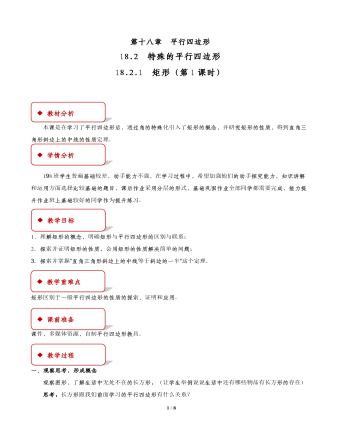
矩形第1课时教案
1. 理解矩形的概念,明确矩形与平行四边形的区别与联系;2.探索并证明矩形的性质,会用矩形的性质解决简单的问题;3.探索并掌握“直角三角形斜边上的中线等于斜边的一半”这个定理.
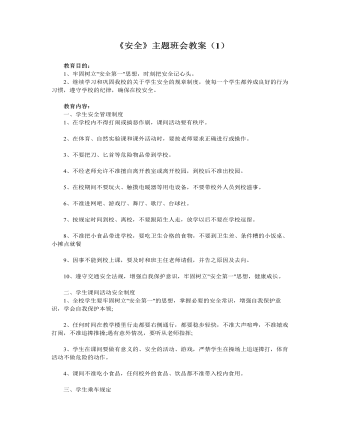
《安全》主题班会教案(1)
教育内容:一、学生安全管理制度1、在学校内不得打闹或搞恶作剧,课间活动要有秩序。2、在体育、自然实验课和课外活动时,要按老师要求正确进行或操作。3、不要把刀、匕首等危险物品带到学校。4、不经老师允许不准擅自离开教室或离开校园,到校后不准出校园。5、在校期间不要玩火、触摸电暖器等用电设备,不要带校外人员到校滋事。6、不准进网吧、游戏厅、舞厅、歌厅、台球社。7、按规定时间到校、离校,不要跟陌生人走,放学以后不要在学校逗留。8、不准把小食品带进学校,要吃卫生合格的食物,不要到卫生差、条件糟的小饭桌、小摊点就餐9、因事不能到校上课,要及时和班主任老师请假,并告之原因及去向。10、遵守交通安全法规,增强自我保护意识,牢固树立"安全第一"思想,健康成长。

